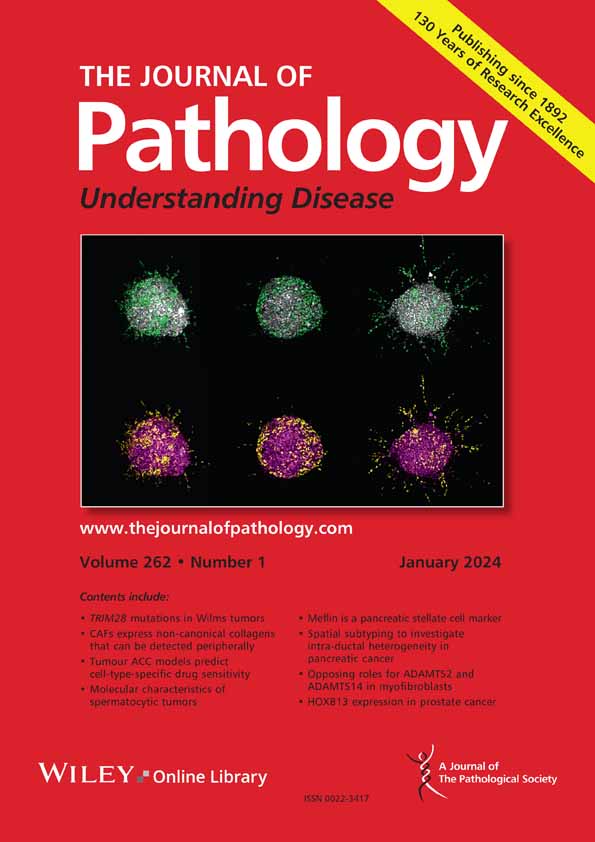求助PDF
{"title":"BIRC3缺乏阻断GOT2的泛素化和降解,阻碍肺鳞状细胞癌的抗肿瘤免疫反应。","authors":"Qiang Zhang, Hongxu Sheng, Dongnan Ping, Jixiang Gao","doi":"10.1002/path.6448","DOIUrl":null,"url":null,"abstract":"<p>In lung squamous cell carcinoma (LUSC), the proportion of exhausted CD8<sup>+</sup> T cells is considerably higher than in lung adenocarcinoma (LUAD). The exhaustion of CD8<sup>+</sup> T cells is responsible for the failure of immunotherapies, as terminally exhausted CD8<sup>+</sup> T cells do not respond to immune checkpoint blockade. Therefore, investigating the regulatory mechanisms underlying CD8<sup>+</sup> T-cell exhaustion in LUSC is essential for potentiating the efficacy of immunotherapy in this context. In our study, cellular assays revealed that elevated expression of <i>GOT2</i> in LUSC reinforced the exhaustion of cocultured CD8<sup>+</sup> T cells, as evidenced by elevated levels of TIGIT and TIM-3, while simultaneously impairing tumor-killing capabilities, as indicated by reduced LDH activity and diminished apoptosis. Animal experiments confirmed that knockdown of <i>GOT2</i> effectively curbed tumor growth and boosted the CD8<sup>+</sup> T cell infiltration and tumor-killing function. Mechanistic studies demonstrated that BIRC3, acting as an E3 ubiquitin ligase, can recognize the 366–372 sequence of GOT2, mediating its ubiquitination and degradation. The deficiency of <i>BIRC3</i> in LUSC interrupted ubiquitination and subsequent degradation of GOT2, leading to elevated GOT2 protein levels, which in turn facilitated CD8<sup>+</sup> T-cell exhaustion and ultimately compromised their antitumor immune responses. Collectively, our findings elucidated the regulatory role of protein ubiquitination in CD8<sup>+</sup> T cell functionality, highlighting a novel approach to enhance the sensitivity of LUSC to immunotherapy through the intervention of the BIRC3/GOT2 ubiquitination axis. © 2025 The Pathological Society of Great Britain and Ireland.</p>","PeriodicalId":232,"journal":{"name":"The Journal of Pathology","volume":"267 2","pages":"142-154"},"PeriodicalIF":5.2000,"publicationDate":"2025-07-21","publicationTypes":"Journal Article","fieldsOfStudy":null,"isOpenAccess":false,"openAccessPdf":"","citationCount":"0","resultStr":"{\"title\":\"BIRC3 deficiency blocks the ubiquitination and degradation of GOT2 to impede antitumor immune responses in lung squamous cell carcinoma\",\"authors\":\"Qiang Zhang, Hongxu Sheng, Dongnan Ping, Jixiang Gao\",\"doi\":\"10.1002/path.6448\",\"DOIUrl\":null,\"url\":null,\"abstract\":\"<p>In lung squamous cell carcinoma (LUSC), the proportion of exhausted CD8<sup>+</sup> T cells is considerably higher than in lung adenocarcinoma (LUAD). The exhaustion of CD8<sup>+</sup> T cells is responsible for the failure of immunotherapies, as terminally exhausted CD8<sup>+</sup> T cells do not respond to immune checkpoint blockade. Therefore, investigating the regulatory mechanisms underlying CD8<sup>+</sup> T-cell exhaustion in LUSC is essential for potentiating the efficacy of immunotherapy in this context. In our study, cellular assays revealed that elevated expression of <i>GOT2</i> in LUSC reinforced the exhaustion of cocultured CD8<sup>+</sup> T cells, as evidenced by elevated levels of TIGIT and TIM-3, while simultaneously impairing tumor-killing capabilities, as indicated by reduced LDH activity and diminished apoptosis. Animal experiments confirmed that knockdown of <i>GOT2</i> effectively curbed tumor growth and boosted the CD8<sup>+</sup> T cell infiltration and tumor-killing function. Mechanistic studies demonstrated that BIRC3, acting as an E3 ubiquitin ligase, can recognize the 366–372 sequence of GOT2, mediating its ubiquitination and degradation. The deficiency of <i>BIRC3</i> in LUSC interrupted ubiquitination and subsequent degradation of GOT2, leading to elevated GOT2 protein levels, which in turn facilitated CD8<sup>+</sup> T-cell exhaustion and ultimately compromised their antitumor immune responses. Collectively, our findings elucidated the regulatory role of protein ubiquitination in CD8<sup>+</sup> T cell functionality, highlighting a novel approach to enhance the sensitivity of LUSC to immunotherapy through the intervention of the BIRC3/GOT2 ubiquitination axis. © 2025 The Pathological Society of Great Britain and Ireland.</p>\",\"PeriodicalId\":232,\"journal\":{\"name\":\"The Journal of Pathology\",\"volume\":\"267 2\",\"pages\":\"142-154\"},\"PeriodicalIF\":5.2000,\"publicationDate\":\"2025-07-21\",\"publicationTypes\":\"Journal Article\",\"fieldsOfStudy\":null,\"isOpenAccess\":false,\"openAccessPdf\":\"\",\"citationCount\":\"0\",\"resultStr\":null,\"platform\":\"Semanticscholar\",\"paperid\":null,\"PeriodicalName\":\"The Journal of Pathology\",\"FirstCategoryId\":\"3\",\"ListUrlMain\":\"https://pathsocjournals.onlinelibrary.wiley.com/doi/10.1002/path.6448\",\"RegionNum\":2,\"RegionCategory\":\"医学\",\"ArticlePicture\":[],\"TitleCN\":null,\"AbstractTextCN\":null,\"PMCID\":null,\"EPubDate\":\"\",\"PubModel\":\"\",\"JCR\":\"Q1\",\"JCRName\":\"ONCOLOGY\",\"Score\":null,\"Total\":0}","platform":"Semanticscholar","paperid":null,"PeriodicalName":"The Journal of Pathology","FirstCategoryId":"3","ListUrlMain":"https://pathsocjournals.onlinelibrary.wiley.com/doi/10.1002/path.6448","RegionNum":2,"RegionCategory":"医学","ArticlePicture":[],"TitleCN":null,"AbstractTextCN":null,"PMCID":null,"EPubDate":"","PubModel":"","JCR":"Q1","JCRName":"ONCOLOGY","Score":null,"Total":0}
引用次数: 0
引用
批量引用




 求助内容:
求助内容: 应助结果提醒方式:
应助结果提醒方式:


